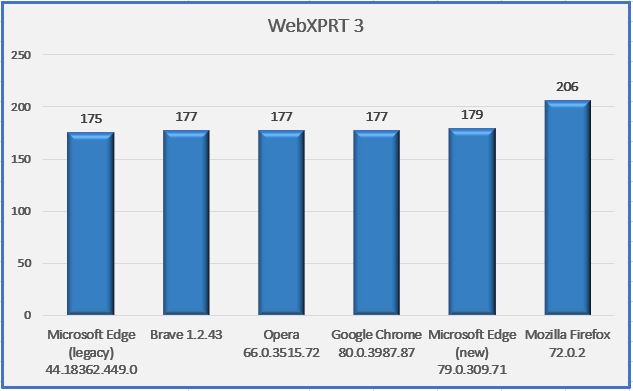WebXPRT continues to be the most widely-used XPRT benchmark, with just over 625,000 runs to date. From the first WebXPRT release in 2013, WebXPRT has been popular with device manufacturers, developers, tech journalists, and consumers because it’s easy to run, it runs on almost anything with a web browser, and its workloads reflect the types of web-based tasks that people are likely to encounter on a daily basis.
We realize that many folks who follow the XPRTs may be unaware of the wide variety of WebXPRT uses that we frequently read about in the tech press. Today, we thought it would be interesting to bring the numbers to life. In addition to dozens of device reviews, here’s a sample of WebXPRT 3 mentions over the past few weeks.
- AnandTech used WebXPRT to compare Firefox, Edge Chromium, Edge Classic, Opera, Chrome, and Internet Explorer browser performance.
- Intel used WebXPRT test data in promotional material for their line of 11th Gen (Tiger Lake) Core processors.
- PCMag used WebXPRT (and CrXPRT) to measure the performance of the Acer Chromebook Spin 713.
- Android TV News used WebXPRT to compare browser performance in various smart TV environments.
- TweakTown used WebXPRT to compare motherboard performance in extensive white box testing.
- LaptopMag used WebXPRT in a Best student Chromebooks for back to school 2020 review.
- PCTempo (Italy) used WebXPRT to compare performance across nine popular browsers.
As we plan for the next version of WebXPRT, we want to be sure we build a benchmark that continues WebXPRT’s legacy of relevant workloads, ease-of-use, and broad compatibility. We know what works well in our lab, but to build a benchmark that meets the needs of a diverse group of users all around the world, it’s important that we hear from all types of testers. We recently discussed some of the new technologies that we’re considering for WebXPRT 4, so please don’t hesitate to let us know what you think about those proposals, or send any additional ideas you may have!
Justin














